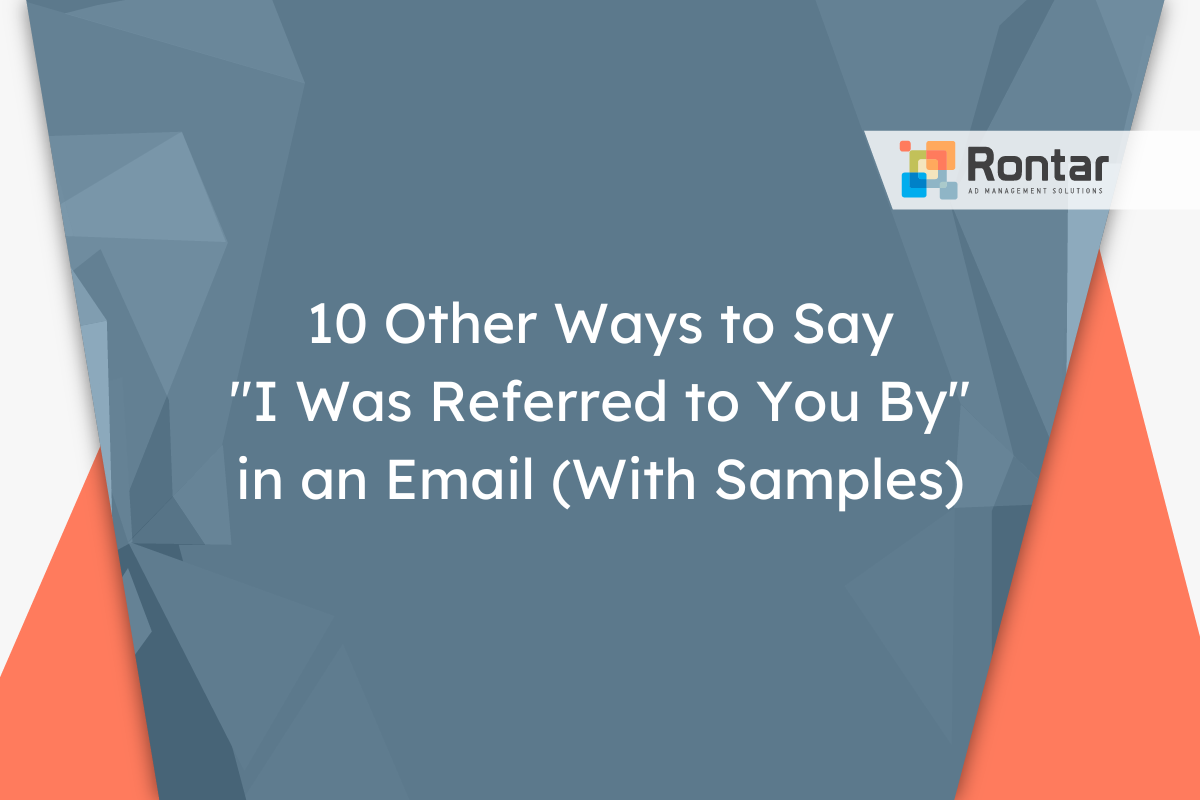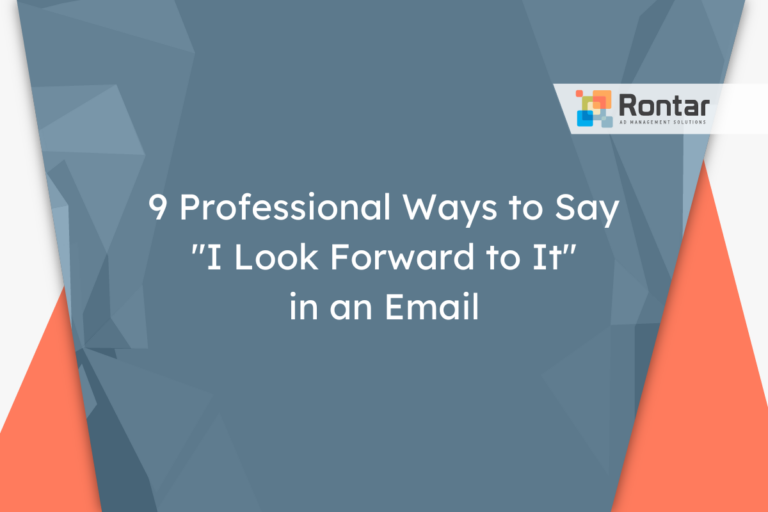10 Other Ways to Say “I Was Referred to You By” in an Email (With Samples)

Reaching out to someone new can sometimes be tricky, especially when someone else recommended you talk to them. The right words can make a big difference.
This article lists ten different ways to say “I was referred to you by” in an email, providing examples and explaining when each alternative is a good choice. Whether you’re seeking a more formal or casual tone, these options can help.
Is It Professional to Say “I Was Referred to You By”?
Yes, it is professional to say “I was referred to you by” in a professional setting. This phrase is also considered formal and polite, making it appropriate for emails and other official communications. Using this phrase is common when you reach out to someone for the first time and you were recommended by a mutual contact. It helps to establish a connection and trust from the beginning.
Here is an example of how you might use this phrase in an email:
Dear Ms. Thompson, I hope this email finds you well. I was referred to you by Michael Johnson, your colleague at XYZ Corporation, who suggested that your expertise in digital marketing might be exactly what I need for my upcoming project. I would love to schedule a meeting to discuss this further and see if there might be an opportunity for us to collaborate. Thank you very much for considering my request. I look forward to your response. Warm regards, Emily Clark
Pros:
- It creates an immediate connection through a mutual acquaintance.
- Indicates the email isn’t spam, as it shows a personal link.
- Makes the recipient more likely to respond positively.
Cons:
- Can seem overly formal in less traditional industries.
- If overused, it may lose its effect of creating a genuine connection.
- Relies on the mutual contact being well-regarded by the recipient.
Sometimes, people might prefer using an alternative to this phrase for various reasons. If the industry is less formal, or if they’re looking to stand out in a sea of similar introductions, using synonyms or different phrasing can be advantageous. Additionally, alternatives might be considered to match the tone of the conversation or the relationship dynamic better. It’s about finding the right balance between being respectful and relatable. Seeking out different options can also be a way to personalize communication and make a stronger impression.
10 Other Ways to Say “I Was Referred to You By” in an Email
When reaching out via email, it’s helpful to have different ways to say you were referred to someone. Here are ten such alternatives:
- Recommended by
- Suggested by
- Introduced by
- Mentioned by
- Endorsed by
- Forwarded by
- Connected by
- Pointed out by
- Referred by
- Directed by
1. Recommended by
This alternative is less formal than the original “I was referred to you by” but still highly professional and polite. It suggests a high level of trust from the person doing the recommending. This phrase is well-suited for emails where you want to immediately convey the value of the connection. It implies a strong endorsement of your skills or need for services.
This alternative is better in contexts where you want to come across as approachable and slightly more informal, while still keeping the message professional.
Dear Mr. Davis, Following a conversation with Elizabeth Kim, I learned about your remarkable work in social enterprise. Recommended by Elizabeth, I am reaching out to discuss potential collaboration opportunities. Best wishes, Alexander Russel
2. Suggested by
Compared to the original, “suggested by” carries a more informal tone but remains polite and professional. This phrase is apt when the person who made the referral did so in a less formal context or setting. It signifies that the suggestion was made based on a casual conversation or observation, rather than a formal endorsement.
This alternative is preferable when you’re reaching out in industries or situations where a more relaxed tone is encouraged. It helps to create a friendly and accessible first impression.
Hi Sarah, Hope you're doing well. Matthew Green mentioned your incredible talent in graphic design. Suggested by Matthew, I'm keen to discuss some ideas I believe you could bring to life. Cheers, James Dean
3. Introduced by
“Introduced by” implies a personal connection and is generally more formal and polite than some of the other alternatives. It’s appropriate for when the referral came as a result of a direct introduction, possibly in person or during a networking event. It conveys a sense of immediacy to the connection.
Use this alternative when the referral stems from a personal introduction. It is especially fitting in professional settings where you want to stress the direct and personal nature of your connection.
Dear Professor Allen, At the recent Global Health Conference, I was introduced by Dr. Janet Leigh to your groundbreaking research on public health. I'd love to learn more about your work and discuss potential collaboration. Sincerely, Terry Crews
4. Mentioned by
“Mentioned by” is a more informal alternative that’s still polite and can be professional depending on the context. It’s well-suited for when the referral happened in passing or as part of a broader conversation. This phrasing suggests a lighter touch and is less direct than an explicit recommendation or endorsement.
This phrase is ideal for contexts where the referral was more casual but still meaningful. It’s particularly useful in less formal industries or when you’ve not directly interacted with the referring individual but came to know of the recipient through them.
Hello Blake, During a chat with Olivia Frost, your expertise in renewable energy was brought up. Mentioned by Olivia, I felt compelled to reach out and explore potential areas for collaboration. Best, Jordan Peel
5. Endorsed by
“Endorsed by” is significantly more formal than the original phrase and implies a strong, positive recommendation. This alternative is particularly professional and suggests that the person recommending you has a high degree of confidence in your abilities or services.
This alternative works best in scenarios where the referral comes with a high level of credibility and authority, such as academic recommendations, high-stakes projects, or when being introduced to a senior executive.
Dear Dr. Simmons, I come to you with a proposal for an innovative research project. Endorsed by Professor Henry Gates, I believe my work could significantly contribute to your laboratory's objectives. Regards, Sophia Chang
6. Forwarded by
Compared to “I was referred to you by,” “forwarded by” is more neutral in terms of formality. It’s polite and can be professional, indicating that your contact information or request was passed along by someone else. This phrase is particularly useful when the referral was made via email or digital means.
Use this alternative when the communication has been initiated through a third party, especially in a digital format. It’s suitable for situations where an email introduction or an online connection kick-started the interaction.
Hello Zoe, Your contact details were forwarded by Chris Park, who suggested you might be the right person to help with our website redesign. Kind regards, Miguel Sanchez
7. Connected by
“Connected by” showcases a modern, slightly informal but still professional approach. It implies a networking action that brought you together with the recipient, suitable for both in-person and online connections. This alternative highlights the act of being brought into contact rather than a strong endorsement.
This phrase is great for cases where networking events or online platforms led to the referral. It suits both casual and professional environments, particularly in industries where networking plays a key role.
Dear Dr. Morgan, I'm reaching out regarding your work in sustainable urban development. We were connected by Laura Jennings at last month's Green Cities Symposium. Warmly, Evan Walsh
8. Pointed out by
“Pointed out by” leans towards the informal side but maintains a polite demeanor. This alternative is suited for when someone highlighted or identified the recipient as a potential contact for you in a more casual manner. It implies a level of recommendation without the formality of an introduction.
This alternative fits well in situations where the recommendation came through casual conversation or in informal settings. It’s useful for less formal industries or less hierarchical organizational structures.
Hey Jordan, I got your contact from Maya, who mentioned your fantastic work with local startups. You were pointed out by Maya as someone I should definitely talk to about my project idea. Cheers, Liam Hudson
9. Referred by
Essentially a synonym for the original phrase, “referred by” is both professional and polite. It conveys the same sense of being recommended by someone but without the additional words making it slightly more direct. This alternative is universally suitable, maintaining formality while being straight to the point.
It’s an excellent choice for all scenarios, especially when you want to keep the message short and sweet. It works across various industries, maintaining a balance between formality and approachability.
Dear Ms. Cooper, I am writing to inquire about the possibility of joining your team. I was referred by Alex Reed, who spoke highly of your leadership in the tech industry. Sincerely, Nadia Torres
10. Directed by
“Directed by” is more formal and suggests a specific instruction or guidance towards making the connection. It is professional and implies a degree of intentionality and purpose behind the referral. This phrase is best when the referrer explicitly advised the contact to seek out the recipient.
This alternative is perfect for situations where there is a direct and intentional effort to connect you for a specific purpose or project. It implies a more deliberate action by the referrer, making it suitable for more structured or formal industries.
Dear Dr. Hughes, In my search for an expert in environmental law, I was directed by Professor Linda Greene to contact you, given your exceptional work in the field. Kind regards, Isaac Kim
Final Thoughts
Choosing the right words when reaching out to someone for the first time can help set a positive tone for your conversation. The alternatives to “I was referred to you by” that we’ve outlined offer a range of options from formal to informal. Whether you need to sound professional, friendly, or somewhere in between, there’s a phrase for you.
Remember, the way you introduce yourself can make a big difference in how your message is received. Using these alternatives wisely can help you make a strong first impression and start your new connection on the right foot.






